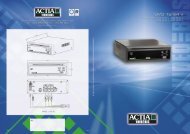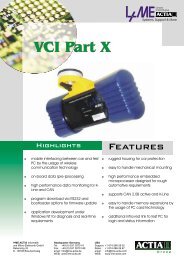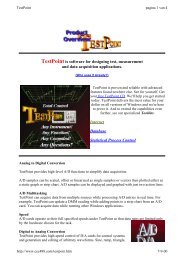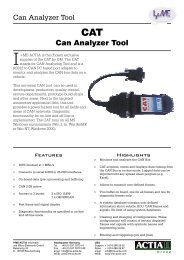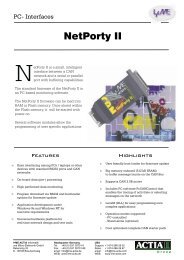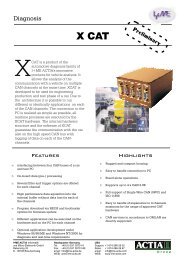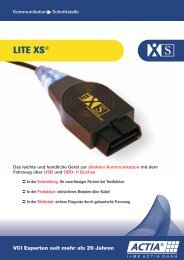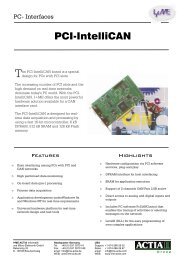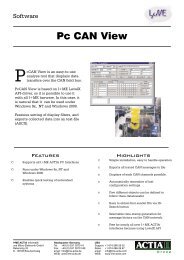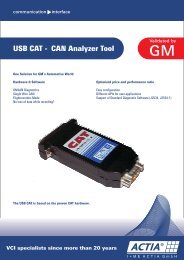User´s Manual - I+ME ACTIA GmbH
User´s Manual - I+ME ACTIA GmbH
User´s Manual - I+ME ACTIA GmbH
Create successful ePaper yourself
Turn your PDF publications into a flip-book with our unique Google optimized e-Paper software.
Physical Addressing<br />
Put in the Diagnostic CAN ID ($24X) corresponding to the USDT request to be sent. (Here $241 has<br />
been assigned to the ECU named ECU.)<br />
The name of the chosen ECU is displayed above 'CAN ID:', if the Diagnostic CAN ID index (here 41)<br />
has been assigned to an ECU in the database. See ECU for details. Otherwise 'unknown' is displayed.<br />
Assign the services to be physical addressed by clicking the right radio button at the end of the line of<br />
the service name.<br />
Note: It is not required that the ECU corresponding to the CAN ID exists in the chosen database as<br />
long as a real node within this Diagnostic CAN ID is part of the CAN system.<br />
Tester Present<br />
Assign the services to be send out with preliminary and continuously send out of Tester Present by<br />
marking the box in front of the line of the service name.<br />
Note: GMLAN requires for some diagnostic services that right before they are sent out by a<br />
diagnostic tool the service Tester Present has to be sent preliminary and then continuously at least every<br />
5 seconds. For the services that require this behavior the boxes are marked with a "*".<br />
Service – Id – sub-function<br />
This table gives an overview about all the diagnostic services and their ID's that are supported by CAT.<br />
Additionally the sub-function ID's, corresponding to the Setup of the service, are displayed (see below).<br />
Setup<br />
Select a service in the table. If the service provides the setup of the sub-function or data parameter, the<br />
Setup button becomes enabled. Click the button to open service specific dialog boxes for the setup.<br />
For more detailed Information about handling and Setup of the different services see:<br />
Clear Trouble Codes<br />
Initiate Diagnostic Operation<br />
Read Failure Record Identifier<br />
Read Failure Record Parameter<br />
Read Data By Identifier<br />
Return to Normal Mode<br />
Read Memory By Address<br />
Security Access – request seed<br />
Security Access – send key<br />
Disable Normal Communication<br />
Write Data By Identifier<br />
Tester Present<br />
Read Trouble Codes<br />
Read Data By Packet Identifier<br />
Device Control<br />
Definition buttons<br />
127




